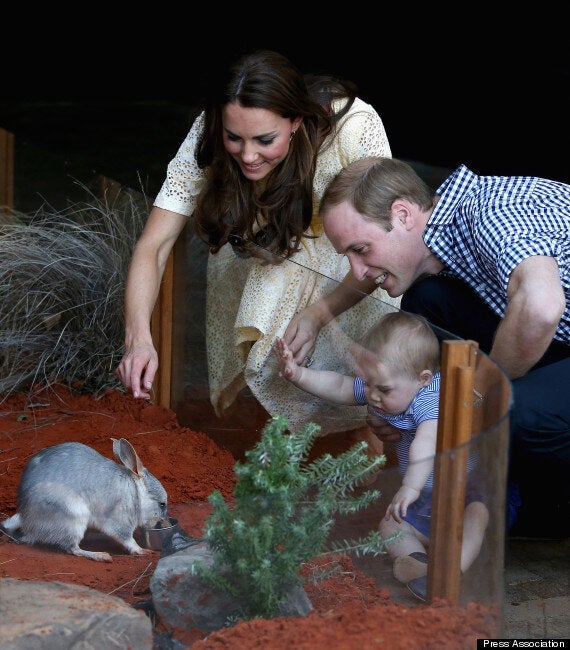Prince George tried to grab an endangered animal during an Easter Sunday zoo visit, prompting Kate Middleton and Prince William to intervene to stop him.
The Duke and Duchess of Cambridge had to step in to protect the bilgy - a rabbit-like marsupial - named after the royal infant, during a visit to Sydney's Taronga zoo.
They had to warn keeper Paul Davies about their son's iron-like grip when he threatened to grab one of the ears of the creature, known as Australia's Easter bunny.

Prince George had to be stopped as he tried to grab the Bilby's ear
His parents took it in turn to hold him in their arms and then to support him as he stood up and held on to a low clear plastic fence that surrounded the marsupial's pen.
At one point they had to grab on to the third in line to the throne when he tried to climb into the enclosure to get at the bilby.
The Duchess, who wore a yellow summer dress by an independent maker, said "he's trying to grab his ear," and William added: "If he gets it he'll never let go".
Mr Davies told the couple it would be fine for George to stroke the animal and went to coax the bilby closer but Kate stepped in to stop him, thinking it a bad idea, saying: "He's got quite a strong grab actually."

The Bilby was renamed 'George' in honour of the third in line to the throne's visit
Zoo officials had to apply to the national Stud Book Keeper to have George, the bilby's new name, officially recognised and his old moniker Boy dropped.
Mr Davies said: "It did take me quite a while to stop calling him, 'Boy George' and he thought the animal looked like a George and was regal too.
He added: "If you think of kings of the past he has got that worldly presence. He has very little fear of anything. He calls his own shots. He is a very confident little animal."
Greater bilbies, nocturnal marsupials who hide in burrows during the day, are rabbit-like creatures with large ears that pick up sounds of insects and have long noses to sniffs out seeds and bulbs.
They were once common in Australia's grassy woodlands but have been driven to the verge of extinction by predators such as foxes and cats and competition from rabbits, all introduced to the country by British settlers.
With only 10,000 left in the wild in northern Queensland and Western Australia, a conservation campaign begun in the late 1960s has gathered pace in the last decade with chocolate Easter bilbies replacing chocolate bunnies in many Australian children's homes.